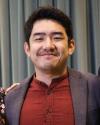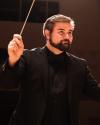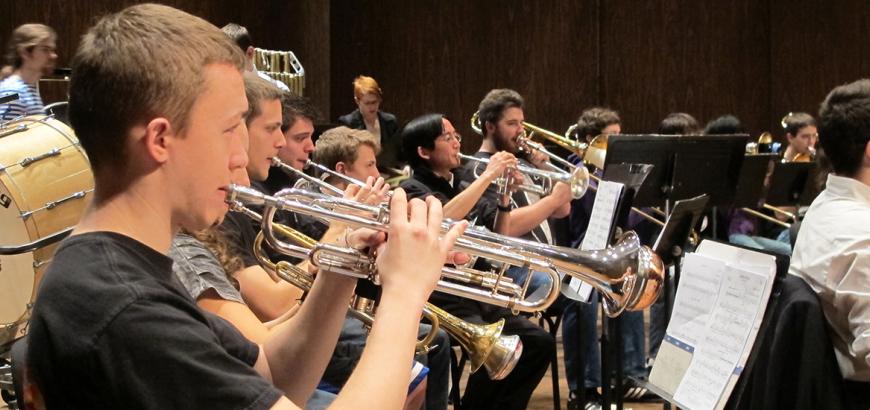The UW Concert and Campus Bands present their Autumn Quarter concert, performing music by John Mackey, Norman Dello Joio, Kelijah Dunton, David Maslanka, and others.
Program
University of Washington Campus Band
Roger Wu Fu, conductor
Tielman Susato (c.a. 1500-c.a. 1564) arr. Dunnigan: Selections from "the Danseryre" (1551/2002)
I. La Morisque
V. Den hoboecken dans
VI. Rondo and Salterelle
VII. Ronde & Aliud
John Mackey (b. 1973): Sheltering Sky (2012)
Norman Dello Joio (1913-2008): Scenes from "The Louvre” (1966)
I. The Portals
III. Kings of France
IV. Nativity Paintings
V. Finale
University of Washington Concert Band
Corey Jahlas, conductor
Kelijah Dunton: Stillwater
David Maslanka: Mother Earth Fanfare
Robert Jager: Third Suite
I. March
II. Waltz
III. Rondo
Program Notes
The Danserye is a set of instrumental dances based on popular tunes of the time, arranged by Susato and published in 1551 as Het derdemusyckboexken. With more than 50 individual dances in a variety of forms, the collection is notable for its simple textures and strict homophony. Specific instrumentation is not indicated, thus suggesting that the tunes were performed by whatever combination of winds and strings was available.
Selections from “The Danserye” is a new setting for wind band consisting of nine dances fashioned into an extended symphonic suite. The arrangement utilizes the full resources of the modern wind band, featuring various sections (or consorts of instruments) in alteration with powerful tutti passages. While the wind parts remain faithful to the original material, the dances are energized with a healthy dose of contemporary percussion effects and a significant part for acoustic guitar. This blend of sound generates a new but familiar element, thus making something very modern out of music that is more than 450 years old.
The arrangement was created for the Florida State University Symphonic Band and was premiered on April 17, 2002. The professional premiere by the Dallas Wind Symphony, Jerry Junkin conducting, was on November 19, 2002, at the Meyerson Symphony Center in Dallas, Texas.
- Program Note by Patrick Dunnigan
The wind band medium has, in the twenty-first century, a host of disparate styles that dominate its texture. At the core of its contemporary development exists a group of composers who dazzle with scintillating and frightening virtuosity. As such, at first listening one might experience John Mackey’s Sheltering Sky as a striking departure. Its serene and simple presentation is a throwback of sorts –- a nostalgic portrait of time suspended.
The work itself has a folksong-like quality –- intended by the composer –- and through this an immediate sense of familiarity emerges. Certainly the repertoire has a long and proud tradition of weaving folksongs into its identity, from the days of Holst and Vaughan Williams to modern treatments by such figures as Donald Grantham and Frank Ticheli. Whereas these composers incorporated extant melodies into their works, however, Mackey takes a play from Percy Grainger. Grainger’s Colonial Song seemingly sets a beautiful folksong melody in an enchanting way (so enchanting, in fact, that he reworked the tune into two other pieces: Australian Up-Country Tune and The Gum-Suckers March). In reality, however, Grainger’s melody was entirely original –- his own concoction to express how he felt about his native Australia. Likewise, although the melodies of Sheltering Sky have a recognizable quality (hints of the contours and colors of Danny Boy and Shenandoah are perceptible), the tunes themselves are original to the work, imparting a sense of hazy distance as though they were from a half-remembered dream.
The work unfolds in a sweeping arch structure, with cascading phrases that elide effortlessly. The introduction presents softly articulated harmonies stacking through a surrounding placidity. From there emerge statements of each of the two folksong-like melodies –- the call as a sighing descent in solo oboe, and its answer as a hopeful rising line in trumpet. Though the composer’s trademark virtuosity is absent, his harmonic language remains. Mackey avoids traditional triadic sonorities almost exclusively, instead choosing more indistinct chords with diatonic extensions (particularly seventh and ninth chords) that facilitate the hazy sonic world that the piece inhabits. Near cadences, chromatic dissonances fill the narrow spaces in these harmonies, creating an even greater pull toward wistful nostalgia. Each new phrase begins over the resolution of the previous one, creating a sense of motion that never completely stops. The melodies themselves unfold and eventually dissipate until at last the serene introductory material returns –- the opening chords finally coming to rest.
- Program Note by Jake Wallace
Scenes from "The Louvre" comes from a 1964 television documentary produced by NBC News called A Golden Prison: The Louvre, for which Dello Joio provided the soundtrack. The documentary tells the history of the Louvre and its world-class collection of art, which is in many ways inseparable from the history of France.
Dello Joio chose to use the music of Renaissance-era composers in his soundtrack in order to match the historical depth of the film. He collected the highlights of this Emmy-winning score into a five-movement suite for band in 1965. The first movement, Portals, is the title music from the documentary, and it consists entirely of Dello Joio’s original material, complete with strident rhythms and bold 20th-century harmony… The stately third movement is based on themes by Louis XIV’s court composer, Jean-Baptiste Lully, and is aptly titled The Kings of France. Movement four, The Nativity Paintings, uses the medieval theme In Dulci Jubilo. The Finale uses the Cestiliche Sonata of Vincenzo Albrici as its source material, to which Dello Joio adds his own harmonic flavor, particularly in the final passages of the piece.
- Program Note from Ohlone Wind Orchestra concert program, 10 November 2013
Mother Earth was composed for the South Dearborn High School Band of Aurora, Indiana, Brian Silvey, conductor. The commission was for a three-minute fanfare piece. Each piece takes on a reason for being all its own, and Mother Earth is no exception. It became an urgent message from Our Mother to treat her more kindly! My reading at the time of writing this music was For a Future to be Possible by the Vietnamese monk and teacher, Thich Nhat Hanh. He believes that the only way forward is to be extremely alive and aware in our present moment, to become awake to the needs of our beloved planet, and to respond to it as a living entity. Music making allows us to come immediately awake. It is an instant connection to the powerful wellspring of our creativity, and opens our minds to the solution of any number of problems, including that of our damaged environment. My little piece does not solve the problem! But it is a living call to the wide-awake life, and it continues to be performed by young people around the world. (Program note by the Composer)
Stillwater is inspired by the beauty of a small town, Stillwater, Minnesota. This town has a big lake in its center, and out of everyone’s backyard it could be seen. During the winter, the very top of the lake freezes and creates this tranquil effect that could not be seen, but heard. When stepping out into your backyard, you’d see this frozen mass, stuck into place and completely unmovable, but if you listened closely, you could hear that the water underneath continued to flow. Why is this important? We as people forget sometimes that we are so much more deep and vast beneath our hard surfaces. We work, we go to school, we take care of our families, we deal with the struggles of the day-to-day routine militantly. But if we just take a moment to listen within ourselves; we discover our passions, our longings, and our sense of belongings. (Program note by the composer)
Robert Jager’s Third Suite is a piece in three movements built on a foundation of quirky melodies and constantly shifting time. Each movement is based around a distorted version of an otherwise typical musical style or structure. The first movement keeps a familiar steady pulse, typical of marches, but creates a lopsided feel by alternating between three, four, and five beats to a bar. The Waltz highlights the woodwind colors with a dance-like melody, but again skews time by taking the typical lifted pulse of three beats, characteristic to a waltz, and adding an extra two beats every so often. The Rondo bases the whole movement around the opening five chords, and brings the piece to an energetic close.
UNIVERSITY OF WASHINGTON CAMPUS BAND
|
DIRECTOR BIOS

M.M Wind Conducting, Peabody Institute of the Johns Hopkins University, 2020
M.Ed. Education, Concordia University Irvine, 2018
B.A. Anthropology, University of California Los Angeles, 2014
Recent works include producing and music directing his original musical “Yappie: The Musical” and its concept album premiere, music directing chamber operas exploring the relationship between growth and suffering in Baltimore’s contemporary opera scene, and presenting research on instrument pedagogy, choice, and personality at Ohio State University. At the Peabody Institute of the Johns Hopkins University, Roger worked as a conductor, performer, teaching assistant and faculty substitute. Through summer conducting workshops, Roger has worked with conductors including Dr. Travis Cross, Dr. Mallory Thompson, Professor Charles Peltz, Dr. Cynthia Johnston Turner, Dr. Mark Scatterday, Professor Kevin McKeown and Dr. Mitchell Fennell. Drawing from his own varied background studying anthropology at the University of California, Los Angeles, and Wind Conducting at Peabody Institute of the Johns Hopkins University, Roger seeks to combine a high standard of musical performance with a rigorous academic approach, always seeking to explore and present music in a new and different light.
Outside of music, Roger works with the mental health foundation Healthy Gamer by providing peer-delivered recovery support services as a group and personal coach. In his offtime, Roger enjoys being a mediocre cook, catching up on popular shows from half a decade ago, and biking. Roger is extremely excited to join the Husky family at UW, and get to know the PNW at large - Go Dawgs!

Originally from Highland, MI, Corey Jahlas is in his first year of the Doctor of Musical Arts and Instrumental Conducting program at the University of Washington, where he serves as a Graduate Student Conductor of the Husky Athletic Bands, co-conductor of the Campus Band, and assistant conductor of the Wind Ensemble.
Most recently, Corey earned his Master of Music in Wind Conducting from Central Michigan University, studying with Prof. Jack Williamson. There, he instructed the 280-member Chippewa Marching Band and served as the instructor on record for the Symphony Band and the University Band. Prior to his Master’s work, Corey taught from 2014-2017 in Oxford, MI, leading the middle school band program, the OMS Percussion Ensemble, and assisting with the OHS Wildcat Marching Band.
Corey also holds degrees in Music Education and Music Theory and Composition from Central Michigan, where he studied euphonium with Dr. Mark Cox and composition with Dr. David Gillingham. Sharing his love for the marching arts, Corey served as Assistant Director of the Madison Scouts Drum and Bugle Corps in 2014, having marched with the group in 2011. He also serves as a clinician, arranger, and drill writer for high schools and university marching bands in Michigan, Ohio, Pennsylvania, and New Hampshire, and is the Director of the Drum Major Camp at Central Michigan University. Corey holds memberships in the National Association for Music Education, Pi Kappa Lambda, Phi Mu Alpha Sinfonia, and Kappa Kappa Psi.
